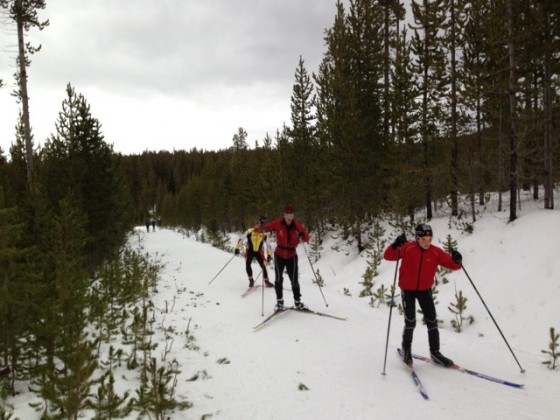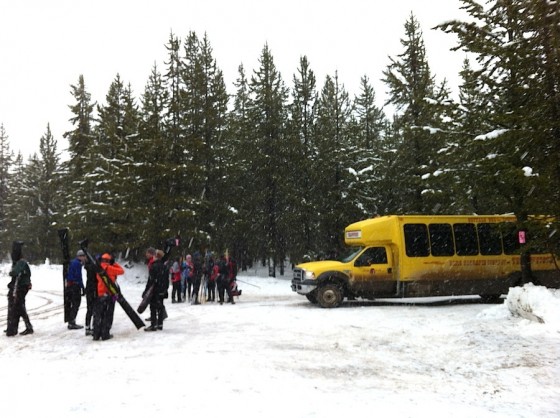
WEST YELLOWSTONE, Mont. – Last week, Yellowstone Ski Festival organizers took a very realistic look at the cards Mother Nature would likely deal them. Most forecasts predicted an undependable amount of snow in the days leading up to the first SuperTour races of the season, which were supposed to take place at the Rendezvous Ski Trails in town.
They could’ve opted to wait and see while doing a nervous snow dance in the meantime, but instead made a contingency plan. Skiing on the South Plateau was always an option, one frequently used by skiers at the start of each season. At elevations between 7,000 and 8,000 feet, the snow tended to stick around longer up there than in West Yellowstone, which sits 6,666 feet above sea level.
The problem was getting people up to there. The access road from town, which belongs to the US Forest Service and lies just outside West Yellowstone National Park, is a hairy one. Not usually plowed, it opens for snowmobile traffic Dec. 1, but anyone who wants to drive six and a half miles to the South Plateau Trail (a snowmobile trail) can do so at their own risk.

If people want to get on snow sooner, they can pull off the single-lane dirt road around mile 4 at the lower gate, the start of the Whiskey Trail. But they need to park far enough on the side for others (including 32- and 14-passenger vans) to pass through.
Festival organizers imagined how this could all play out with thousands of skiers flocking to the plateau on Thanksgiving week. Not handled properly, it could be a mess.
“We’re still putting a plan into place,” assistant director Steve Hoovler said Tuesday, the second day organizers provided a complementary shuttle service from town to the upper parking lot at the South Plateau trailhead.
It was the first time they implemented such a transport plan, offered Monday through Wednesday from 8 a.m. to 4 p.m. with a more limited schedule tentatively planned for Friday and Saturday. Hoovler said they rounded up three donated shuttles to run continuously as a practical means of getting up the road safely.
Four years ago, race organizers had a similar situation when low-snow conditions moved the International Ski Federation (FIS) sanctioned races to the South Plateau, which skirts the western edge of West Yellowstone National Park and the Idaho border. But they didn’t offer shuttles back then.
“That was something we were not expecting to have to deal with,” Hoovler said. “The main reason we’re having a shuttle is we had some large teams from back East that came and brought a large number of kids in big buses and there was no way to get those kids up, and [essentially] they were stuck in town.”
Once festival organizers got the go-ahead from the forest service to open the plateau to traffic, they had to hire an independent contractor to plow and sand the roads. They also had to figure out schedule for uphill and downhill traffic to eliminate any two-way scenarios, and finally, devise a plan to get busloads of skiers – mostly juniors – up there safely.
But there was another added element: while they could limit traffic to one way, with shuttles leaving every hour and other vehicles following them up and down, organizers couldn’t prevent others from using what was essentially a public road.
Theoretically, anyone could drive up to hunt elk or big game this time of year. Snowmobilers in Idaho could cross over from the backside while using a nearly 400-mile trail system, which includes the South Plateau and Whiskey trails.
Race organizers couldn’t prevent snowmobilers from doing so, but they could put up signs warning them of the cross-county skiers ahead. Fortunately from the West Yellowstone side, snowmobile rentals didn’t start until December.
Last time organizers had to move the races higher in 2008, Hoovler said they didn’t have much control over the road. That was the first time anything of that magnitude had been held on the plateau, with a hefty amount of skiers and spectators coming out for elite racing and recreational skiing.
“We definitely have that advantage this time; we’ve been up there so we have an idea of where we can go and what we can work with,” Hoovler said. “In 2008 we were reacting to everything, and this time we can plan a little bit more.”
Still, the logistics required some trial and error. On Monday, some independent drivers parked in impassable spots alongside the road. The first shuttles didn’t start on time, which delayed the schedule for the rest of the day.
Each one-way trip to the upper parking lot takes about 30 minutes, leaving skiers with nearly an hour to ski between shuttles. There was no lodge or place to keep warm or dry with wet snow falling at times, and on Monday, organizers brought in port-o-potties.
According to Hoovler, Tuesday went much smoother. The vans took off on time and most people were able to catch a ride down if they correctly timed the shuttle schedule. At certain peak times, like noon, there were too many skiers than seats available and some people had to wait an hour for the next ride.
“We’ve definitely had some hurdles,” he said. “It’s a tight space so we’re trying to get as many people up there skiing and turned around as we can. We’re running into hiccups now and there; everyone’s having to make concessions. It was certainly a learning curve for everybody.”
At the bottom, local celebrity Tom Barr, who works for the forest service and has checked trail passes at Rendezvous for years, switched roles to direct traffic and provide information. Four volunteers were stationed along the road to help drivers park in designated spots, and local caterers donated lunches to keep the three shuttle drivers nourished during their seven roundtrips each day.
In all, the shuttles would log about 820 miles in three days, which the festival had to budget additionally for to pay for fuel. Organizers intended to shuttle people Friday and Saturday for the races, with a schedule pending a meeting on Wednesday afternoon.
While the shuttles won’t run Thursday on Thanksgiving, Hoovler said the road will be open to traffic. As advised by the festival’s publicized travel restrictions, four-by-four and studded tires, even chains, are strongly recommended.
“The road is in good shape, but it’s slick and narrow in places where the parking is tight,” Hoovler said. “There’s not much room to maneuver and we’ve had a lot of two-wheel drive vehicles get stuck in that situation.”
That said, people have been driving up there since the ’70s and been an important part of the early season skiing in West Yellowstone ever since.
“Even on a normal year where we’ve would’ve been skiing up there,” Hoovler said. “The big difference between is there’s typically a lot more snow up there than in town. … It’s a low-snow year for the plateau.”
Alex Kochon
Alex Kochon (alexkochon@gmail.com) is a former FasterSkier editor and roving reporter who never really lost touch with the nordic scene. A freelance writer, editor, and outdoor-loving mom of two, she lives in northeastern New York and enjoys adventuring in the Adirondacks. She shares her passion for sports and recreation as the co-founder of "Ride On! Mountain Bike Trail Guide" and a sales and content contributor at Curated.com. When she's not skiing or chasing her kids around, Alex assists authors as a production and marketing coordinator for iPub Global Connection.
